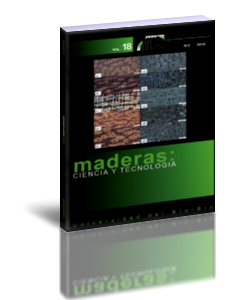Effect of extractive content on the thermal stability of two wood species from Brazil
Keywords:
Activation energy, Eucalyptus grandis, Pinus taeda, thermal degradation, thermogravimetric analysis.Abstract
The influence of extractive content on the thermal stability and kinetic degradation of two wood species has been investigated using chemical analysis and thermogravimetry. Two wood species were studied: Pinus taeda and Eucalyptus grandis. Thermogravimetric results showed that higher extractive contents in the wood accelerate the degradation process and promote an increase in the conversion values at lower temperatures reducing the wood thermal stability. After removing the extractives from wood the thermal stability for both wood species increased. The results also demonstrated that prior information about the wood composition can be helpful to increase the range of industrial applicationsof wood.
Downloads
References
Bianchi,O.; Dal Castel, C.; de Oliveira, R.V.B.; Bertuoli, P.T.; Hillig, É. 2010. Nonisothermal degrdation of wood using thermogravimetric measurements. Polímeros 20:395-400.
Brazil. 2004. NBR 10.007: Sampling of solid waste. Associação Brasileira de Normas Técnicas.
Coloma, J.; Reyes, L.; Navarrete, J.; Alarcón, J.; Delgado, L.; Vera, R.; Ubilla, P.; Vásquez, K.; Becerra, J. 2015. Effect of Albino Ophiostoma strains on Eucalyptus nitens extractives. Maderas. Ciencia y Tecnología 17(1):161-170.
Dorado, J.; Claassen, F.W.; van Beek, T.A.; Lenon, G.; Winjnberg, J.B.P.A.; Sierra-Alvarez, R. 2000. Elimination and detoxification of softwood extractives by white-rot fungi. Journal of Biotechnology 80:231-240.
Guo, X.; Wang, S.; Wang, K.; Liu, Q.; Luo, Z. 2010. Influence of extractives on mechanism of biomass pyrolysis. Journal of Fuel Chemistry and Technology 38(1):42-46.
He, W.; Hu, H. 2013. Prediction oh hot-water-soluble extractive, pentosan and cellulose content of various wood species using FT-NIR spectroscopy. Bioresource Technology 140:299-305.
Horowitz, H. H.; Metzger, G. 1963. A new analysis of thermogravimetric traces. Analytical Chemistry 35:1464-1468.
Ishida, Y.; Goto, K.; Yokoi, H.; Tsuge, S.; Ohtani, H.; Sonoda, T.; Ona, T. 2007. Direct analysis of phenolic extractives in wood by thermochemimolysis-gas chromatography in the presence of tetrabutylammonium hydroxide. Journal of Analytical and Applied Pyrolysis 78:200-206.
Islam, Md.A.; Asif, M.; Hameed, B.H. 2015. Pyrolysis kinetics of raw and hydrothermally carbonized Karanj (Pongamia pinnata) fruit hulls via thermogravimetric analysis. Bioresource Technology 179:227-233.
Kilulya, K.; Msagati, T.A.M.; Mamba, B.B.; Ngila, J.C.; Brush, T. 2014. Effect of site, species and tree size on the quantitative variation of lipophilic extractives in Eucalyptus woods used for pulping in South Africa. Industrial Crops and Products 56:166-174.
Pétrissans, A.; Younsi, R.; Chaouch, M.; Gérardin, P.; Pétrissans, M. 2014. Wood thermodegradation: experimental analysis and modeling of mass loss kinetics. Maderas-Cienc Tecnol 16(2):133-148.
Poletto, M.; Dettenborn, J.; Pistor, V.; Zeni, M.; Zattera, A.J. 2010. Materials produced from plant biomass. Part I: evaluation of thermal stability and pyrolysis of wood. Materials Research 13(3):375-379.
Poletto, M.; Zattera, A.J.; Forte, M.M.C.; Santana, R.M. 2012a. Thermal decomposition of wood: influence of wood components and cellulose crystallite size. Bioresource Technology 109:148-153.
Poletto, M.; Zattera, A.J.; Santana, R.M. 2012b. Structural differences between wood species: evidence from chemical composition, FTIR spectroscopy, and thermogravimetric analysis. Journal of Applied Polymer Science 126:E336-E343.
Poletto, M.; Zattera, A.J.; Santana, R.M. 2012c. Thermal decomposition of wood: kinetics and degradation mechanisms. Bioresource Technology 126:7-12.
Popescu, M.C.; Popescu, C.M.; Lisa, G.; Sakata, Y. 2011. Evaluation of morphological and chemical aspects of different wood species by spectroscopy and thermal methods. Journal of Molecular Strucuture 988:65-72.
Sanchez-Silva, L.; López-González, D.; Villaseñor, Sánchez, P.; Valverde, J.L. 2012. Thermogravimetric-mass spectrometric analysis of lignocellulosic and marine biomass pyrolysis. Bioresource Technology 109:163-172.
Saputra, H.; Simonsen, J.; Li, K. 2004. Effect of extractives on the flexural properties of wood/ plastic composites. Composite Interfaces 11(7):515-524.
Shebani, A.N.; Van Reenen, A.J.; Meincken, M. 2008. The effect of wood extractives on the termal stability of different wood species. Thermochimica Acta 471:43-50.
Shebani, A.N.; Van Reenen, A.J.; Meincken, M. 2009. The effect of wood extractives on the termal stability of different wood-LLDPE composites. Thermochimica Acta 481:52-56.
Sheshmani, S. 2013. Effects of extractives on some properties of bagasse/high density polypropylene composites. Carbohydrate Polymers 94:416-419.
Silvério, F.O.; Barbosa, L.C.A.; Maltha, C.R.A.; Fridêncio, P.H.; Cruz, M.P.; Veloso, D.P.; Milanez, A.F. 2008. Effect of storage time on the composition and content of wood extractives in Eucalyptus cultivated in Brazil. Bioresource Technology 99:4878-4886.
Slopiecka, K.; Bartocci, P.; Fantozzi, F. 2012. Thermogravimetric analysis and kinetic study of poplar wood pyrolysis. Applied Energy 97:491.497.
Tenório, C.; Moya, R. 2013. Thermogravimetric characteristics, its relation with extractives and chemical properties and combustion characteristics of ten fast-growth species in Costa Rica. Thermochimica Acta 563:12-21.
Toscano, G.; Duca, D.; Rossini, G.; Mengarelli, C.; Pizzi, A. 2015. Identification of diffetent Woody biomass for energy purpose by means of Soft Independent Modeling of Class Analogy applied to thermogravimetric analysis. Energy 83:351-357.
Wongsiriamnuay, T.; Tippayawong, N. 2010. Thermogravimetric analysis of giant sensitive plants under air atmosphere. Bioresource Technology 101:9314-9320.
Zhang, J.; Chen, T.; Wu, J.; Wu, J. 2014. Multi-Gaussian-DAEM-reaction model for thermal decompositions of cellulose, hemicellulose and lignin: comparison of N2 and CO2 atmosphere.

































